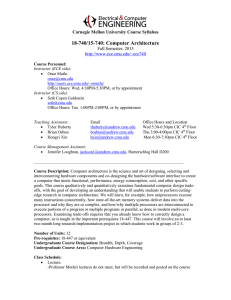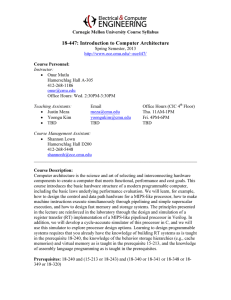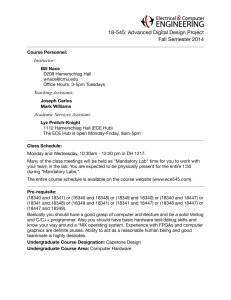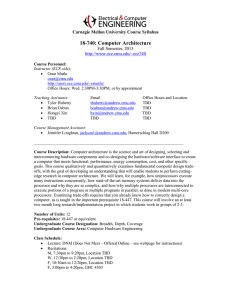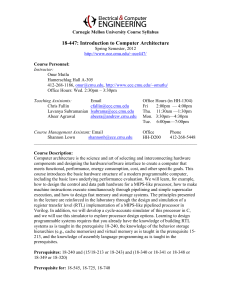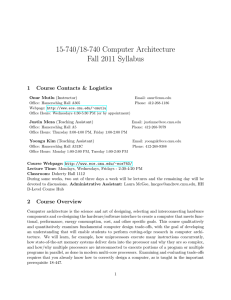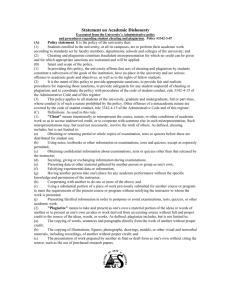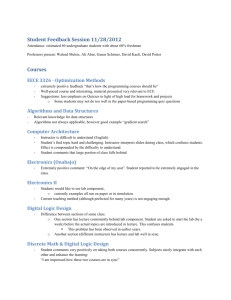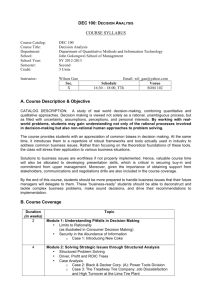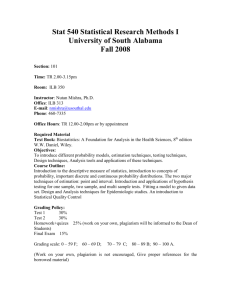Course Syllabus - Visualization and Image Analysis (VIA) lab
advertisement
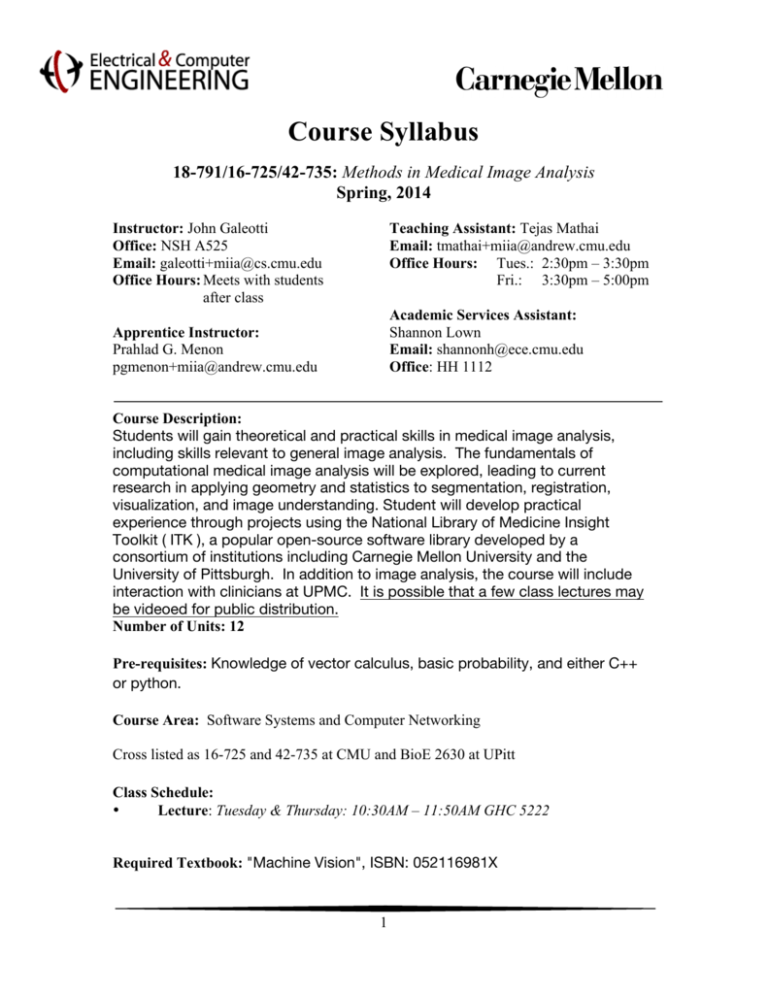
Course Syllabus 18-791/16-725/42-735: Methods in Medical Image Analysis Spring, 2014 Instructor: John Galeotti Office: NSH A525 Email: galeotti+miia@cs.cmu.edu Office Hours: Meets with students after class Teaching Assistant: Tejas Mathai Email: tmathai+miia@andrew.cmu.edu Office Hours: Tues.: 2:30pm – 3:30pm Fri.: 3:30pm – 5:00pm Academic Services Assistant: Shannon Lown Email: shannonh@ece.cmu.edu Office: HH 1112 Apprentice Instructor: Prahlad G. Menon pgmenon+miia@andrew.cmu.edu Course Description: Students will gain theoretical and practical skills in medical image analysis, including skills relevant to general image analysis. The fundamentals of computational medical image analysis will be explored, leading to current research in applying geometry and statistics to segmentation, registration, visualization, and image understanding. Student will develop practical experience through projects using the National Library of Medicine Insight Toolkit ( ITK ), a popular open-source software library developed by a consortium of institutions including Carnegie Mellon University and the University of Pittsburgh. In addition to image analysis, the course will include interaction with clinicians at UPMC. It is possible that a few class lectures may be videoed for public distribution. Number of Units: 12 Pre-requisites: Knowledge of vector calculus, basic probability, and either C++ or python. Course Area: Software Systems and Computer Networking Cross listed as 16-725 and 42-735 at CMU and BioE 2630 at UPitt Class Schedule: • Lecture: Tuesday & Thursday: 10:30AM – 11:50AM GHC 5222 Required Textbook: "Machine Vision", ISBN: 052116981X 1 Optional Textbook: "Insight to Images", ISBN: 9781568812175. Course URL: http://www.cs.cmu.edu/~galeotti/methods_course/ You should check the course website daily for announcements and handouts. Course Blackboard: To access the course blackboard from an Andrew Machine, go to the login page at: http://www.cmu.edu/blackboard. Note that for most purposes the course website will be used instead of blackboard. Course Wiki: Students are encouraged to use the ECE wiki to provide feedback about the course at: http://wiki.ece.cmu.edu/index.php. Grading Algorithm: • • • • • Method: The point system ◦ Each question or problem in a quiz or homework is assigned a point value ◦ Your cumulative grade for quizzes [or homeworks] is (the sum of points your earned on all quizzes) divided by (the sum of points you could have earned on all quizzes) ◦ So, your course grade is equally affected whether you miss 1 point on a 3 point quiz, or you miss 1 point on a 10 point quiz. (This is not the case for the more typical "averaged percentages" method.) Attendance: Required ◦ Checked using Quizzes ◦ On some days the quiz may be signing your name on the roll. ◦ Some days may not have any quiz at all (attendance not checked). Quizzes: 20% ◦ Not present / not taken = 0 ◦ Lowest 2 are dropped (the 2 on which you missed the most points) ◦ So, if you are gone for a week-long conference, then the 2 0's won't count. ◦ In case of extenuating circumstances requiring further absence, talk to me, but I must be fair to the class (i.e. harder on you). Homework: 30% ◦ Your TA will help you before the assignment is due. When grading, he will not try to figure out a non-working mess of code! ◦ Late policy: 0% for code that does not compile, run, and at least perform some part of the assignment. However, if you've made a reasonable effort in advance and have been working with the TA but still have not been able to get things to work, then we will be much more generous with partial credit and/or extra time, on a case-by-case basis. ◦ Also, if you using a different compiler than the TA, then you will be given a brief period of time to fix unforeseen cross-platform incompatibilities. Shadow Program: 10% ◦ You submit 1 report for each clinical station you visit. 2 ◦ • • The first time you miss a station for which you are scheduled (without good reason), you may contact your instructor to reschedule for 50% credit for that station. ◦ If you do not show up a second time, you will be removed from the Shadow Program, get a 0 for all subsequent stations, and your instructor will be very unhappy with you. Final Project: 40% ◦ 15% presentation ◦ 25% code Final Letter Grade ◦ While lower cutoffs may be used, the following maximum grade cutoffs are guaranteed: ◦ >= 93.5 A ◦ >= 90.0 A◦ >= 87.5 B+ ◦ >= 83.5 B ◦ >= 80.0 B- Tentative Course Calendar: A tentative course calendar is listed on the course website (see above). The lecture schedule (and some topics) are subject to change, depending in part on class interest and involvement. Education Objectives (Relationship of Course to Program Outcomes) (a) an ability to apply knowledge of mathematics, science, and engineering: Theoretical and practical lectures are combined with practical and empirical exercises to prepare students for a large-scale science/engineering final project. (b) an ability to design and conduct experiments, as well as to analyze and interpret data: Class exercises require students to design, build, and run experiments in software to empirically optimize their projects’ algorithm architecture and parameter tuning. (c) an ability to design a system, component, or process to meet desired needs within realistic constraints such as economic, environmental, social, political, ethical, health and safety, manufacturability, and sustainability: The final projects require students to build a working system that address a real need, either by providing new computational tools or by making new discoveries. Required interaction with practicing clinicians and class lectures both expose students to the dominant constraints in the various domains of biomedical image analysis, including matters of usability, patient safety, and legal liability. (d) an ability to function on multi-disciplinary teams: 3 The entire class is multi-disciplinary, requiring students to interact with clinicians, biologists, and/or engineers. Homework assignments and the final project require engineering approaches to biomedical problems in order to derive clinically/scientifically meaningful results. (e) an ability to identify, formulate, and solve engineering problems: As a project-based course, students must continually solve engineering problems. The final projects further require students to individually identify relevant biomedical problems, formulate an engineering approach, and then proceed to (at least partially) solve their chosen problems (f) an understanding of professional and ethical responsibility: Ethical matters of patient safety and legal liability are discussed when relevant to other lecture materials, as part of projects, and when shadowing clinicians. (g) an ability to communicate effectively: The final projects require individual student presentations, roughly equivalent to an oral conference presentation. Although students are graded primarily on technical content, they are also graded on the clarity, polish, and length of their presentation. (h) the broad education necessary to understand the impact of engineering solutions in a global, economic, environmental, and societal context: [see item (c) above regarding economic and societal constraints and impact] (i) a recognition of the need for, and an ability to engage in life-long learning The course repeatedly stresses the need to always consult the latest scientific literature when seeking to build useful systems, and makes use of current papers for some of the lectures. The textbook was chosen in part due to its extensive references which provide an excellent cross-reference starting point from which relevant current literature can be found. (j) a knowledge of contemporary issues: Biomedical image analysis is a driving factor for many recent developments in the medical and biological communities. Students are instructed and shown that building useful systems requires knowledge of contemporary practice, workflow, and limitations within these communities, so that the students’ final systems will be both usable and relevant to current research/medicine. (k) an ability to use the techniques, skills, and modern engineering tools necessary for engineering practice: 4 As a project based course, students are taught and required to use a wide variety of techniques, skills and engineering tools to solve a variety of biomedical image analysis problems. Academic Integrity Policy (http://www.ece.cmu.edu/student/integrity.html): The Department of Electrical and Computer Engineering adheres to the academic integrity policies set forth by Carnegie Mellon University and by the College of Engineering. ECE students should review fully and carefully Carnegie Mellon University's policies regarding Cheating and Plagiarism; Undergraduate Academic Discipline; and Graduate Academic Discipline. ECE graduate student should further review the Penalties for Graduate Student Academic Integrity Violations in CIT outlined in the CIT Policy on Graduate Student Academic Integrity Violations. In addition to the above university and college-level policies, it is ECE's policy that an ECE graduate student may not drop a course in which a disciplinary action is assessed or pending without the course instructor's explicit approval. Further, an ECE course instructor may set his/her own course-specific academic integrity policies that do not conflict with university and college-level policies; course-specific policies should be made available to the students in writing in the first week of class. This policy applies, in all respects, to this course. Carnegie Mellon University's Policy on Cheating and Plagiarism (http://www.cmu.edu/policies/documents/Cheating.html) states the following, Students at Carnegie Mellon are engaged in preparation for professional activity of the highest standards. Each profession constrains its members with both ethical responsibilities and disciplinary limits. To assure the validity of the learning experience a university establishes clear standards for student work. In any presentation, creative, artistic, or research, it is the ethical responsibility of each student to identify the conceptual sources of the work submitted. Failure to do so is dishonest and is the basis for a charge of cheating or plagiarism, which is subject to disciplinary action. Cheating includes but is not necessarily limited to: 1. Plagiarism, explained below. 2. Submission of work that is not the student's own for papers, assignments or exams. 3. Submission or use of falsified data. 4. Theft of or unauthorized access to an exam. 5. Use of an alternate, stand-in or proxy during an examination. 6. Use of unauthorized material including textbooks, notes or computer programs in the preparation of an assignment or during an examination. 7. Supplying or communicating in any way unauthorized information to another student for the preparation of an assignment or during an examination. 5 8. Collaboration in the preparation of an assignment. Unless specifically permitted or required by the instructor, collaboration will usually be viewed by the university as cheating. Each student, therefore, is responsible for understanding the policies of the department offering any course as they refer to the amount of help and collaboration permitted in preparation of assignments. 9. Submission of the same work for credit in two courses without obtaining the permission of the instructors beforehand. Plagiarism includes, but is not limited to, failure to indicate the source with quotation marks or footnotes where appropriate if any of the following are reproduced in the work submitted by a student: 1. A phrase, written or musical. 2. A graphic element. 3. A proof. 4. Specific language. 5. An idea derived from the work, published or unpublished, of another person. This policy applies, in all respects, to 18-791/16-725/42-735. 6
